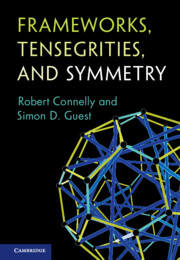Refine search
Actions for selected content:
2002 results in Engineering design, kinematics, and robotics
11 - Generating Stable Symmetric Tensegrities
- from Part II - Symmetric Structures
-
- Book:
- Frameworks, Tensegrities, and Symmetry
- Published online:
- 13 January 2022
- Print publication:
- 27 January 2022, pp 234-268
-
- Chapter
- Export citation
Preface
-
- Book:
- Frameworks, Tensegrities, and Symmetry
- Published online:
- 13 January 2022
- Print publication:
- 27 January 2022, pp xi-xiv
-
- Chapter
- Export citation
Contents
-
- Book:
- Frameworks, Tensegrities, and Symmetry
- Published online:
- 13 January 2022
- Print publication:
- 27 January 2022, pp vii-x
-
- Chapter
- Export citation
3 - First-Order Analysis of Frameworks
- from Part I - The General Case
-
- Book:
- Frameworks, Tensegrities, and Symmetry
- Published online:
- 13 January 2022
- Print publication:
- 27 January 2022, pp 17-61
-
- Chapter
- Export citation
Frontmatter
-
- Book:
- Frameworks, Tensegrities, and Symmetry
- Published online:
- 13 January 2022
- Print publication:
- 27 January 2022, pp i-iv
-
- Chapter
- Export citation
8 - Finite Mechanisms
- from Part I - The General Case
-
- Book:
- Frameworks, Tensegrities, and Symmetry
- Published online:
- 13 January 2022
- Print publication:
- 27 January 2022, pp 155-184
-
- Chapter
- Export citation
Part II - Symmetric Structures
-
- Book:
- Frameworks, Tensegrities, and Symmetry
- Published online:
- 13 January 2022
- Print publication:
- 27 January 2022, pp 185-186
-
- Chapter
- Export citation
9 - Groups and Representation Theory
- from Part II - Symmetric Structures
-
- Book:
- Frameworks, Tensegrities, and Symmetry
- Published online:
- 13 January 2022
- Print publication:
- 27 January 2022, pp 187-204
-
- Chapter
- Export citation
Part I - The General Case
-
- Book:
- Frameworks, Tensegrities, and Symmetry
- Published online:
- 13 January 2022
- Print publication:
- 27 January 2022, pp 7-8
-
- Chapter
- Export citation
References
-
- Book:
- Frameworks, Tensegrities, and Symmetry
- Published online:
- 13 January 2022
- Print publication:
- 27 January 2022, pp 271-279
-
- Chapter
- Export citation
1 - Introduction
-
- Book:
- Frameworks, Tensegrities, and Symmetry
- Published online:
- 13 January 2022
- Print publication:
- 27 January 2022, pp 1-6
-
- Chapter
- Export citation
2 - Frameworks and Rigidity
- from Part I - The General Case
-
- Book:
- Frameworks, Tensegrities, and Symmetry
- Published online:
- 13 January 2022
- Print publication:
- 27 January 2022, pp 9-16
-
- Chapter
- Export citation
Dedication
-
- Book:
- Frameworks, Tensegrities, and Symmetry
- Published online:
- 13 January 2022
- Print publication:
- 27 January 2022, pp v-vi
-
- Chapter
- Export citation
Index
-
- Book:
- Frameworks, Tensegrities, and Symmetry
- Published online:
- 13 January 2022
- Print publication:
- 27 January 2022, pp 280-284
-
- Chapter
- Export citation
5 - Energy Functions and the Stress Matrix
- from Part I - The General Case
-
- Book:
- Frameworks, Tensegrities, and Symmetry
- Published online:
- 13 January 2022
- Print publication:
- 27 January 2022, pp 78-109
-
- Chapter
- Export citation
10 - First-Order Symmetry Analysis
- from Part II - Symmetric Structures
-
- Book:
- Frameworks, Tensegrities, and Symmetry
- Published online:
- 13 January 2022
- Print publication:
- 27 January 2022, pp 205-233
-
- Chapter
- Export citation
Appendix A - Useful Theorems and Proofs
-
- Book:
- Frameworks, Tensegrities, and Symmetry
- Published online:
- 13 January 2022
- Print publication:
- 27 January 2022, pp 269-270
-
- Chapter
- Export citation
4 - Tensegrities
- from Part I - The General Case
-
- Book:
- Frameworks, Tensegrities, and Symmetry
- Published online:
- 13 January 2022
- Print publication:
- 27 January 2022, pp 62-77
-
- Chapter
- Export citation
6 - Prestress Stability
- from Part I - The General Case
-
- Book:
- Frameworks, Tensegrities, and Symmetry
- Published online:
- 13 January 2022
- Print publication:
- 27 January 2022, pp 110-134
-
- Chapter
- Export citation

Frameworks, Tensegrities, and Symmetry
-
- Published online:
- 13 January 2022
- Print publication:
- 27 January 2022
